Boss ES-5 User Manual

 Owner’s Manual
Owner’s Manual
Main features
The ES-5 is a switching system that lets you connect effect pedals and other effect units, and then store and recall up to 200 different combinations of them.
It also provides a wide variety of external control functions for controlling your amp and effects in real time.
Contents
Panel Descriptions. . . . . . . . . . . . . . . . . . . . . . . . . . . . . . . . . . . . . . . . . |
2 |
Rear Panel (Connecting Your Equipment). . . . . . . . . . . . . . . . . . . . |
2 |
Top Panel.. . . . . . . . . . . . . . . . . . . . . . . . . . . . . . . . . . . . . . . . . . . . . . . |
4 |
Attaching the Rubber Feet.. . . . . . . . . . . . . . . . . . . . . . . . . . . . . . . . |
5 |
Turning the Power On and Off . . . . . . . . . . . . . . . . . . . . . . . . . . . . . |
5 |
Switching the Play Screen . . . . . . . . . . . . . . . . . . . . . . . . . . . . . . . . . |
5 |
Saving/Recalling a Combination of Effect Units |
|
(Memory Mode) . . . . . . . . . . . . . . . . . . . . . . . . . . . . . . . . . . . . . . . . . . . |
6 |
Patch Structure.. . . . . . . . . . . . . . . . . . . . . . . . . . . . . . . . . . . . . . . . . . |
6 |
Switching Between Memory and Manual Modes . . . . . . . . . . . . . |
6 |
Saving a Patch (Patch Write) . . . . . . . . . . . . . . . . . . . . . . . . . . . . . . . |
6 |
Recalling a Patch (Patch Change). . . . . . . . . . . . . . . . . . . . . . . . . . . |
6 |
Creating a Patch. . . . . . . . . . . . . . . . . . . . . . . . . . . . . . . . . . . . . . . . . . . |
7 |
Block Diagram . . . . . . . . . . . . . . . . . . . . . . . . . . . . . . . . . . . . . . . . . . . |
7 |
Tips for Creating Patches (Sounds). . . . . . . . . . . . . . . . . . . . . . . . . . |
7 |
Changing the Effect Loop Settings. . . . . . . . . . . . . . . . . . . . . . . . . . |
8 |
Changing the Effect Loop Connection Order. . . . . . . . . . . |
8 |
Making a Parallel Connection. . . . . . . . . . . . . . . . . . . . . . . . . |
8 |
Specifying Carryover . . . . . . . . . . . . . . . . . . . . . . . . . . . . . . . . |
8 |
Editing the Settings of a Patch (Memory Edit Mode) . . . . . . . . . . |
9 |
Basic Operation. . . . . . . . . . . . . . . . . . . . . . . . . . . . . . . . . . . . . |
9 |
Parameter List. . . . . . . . . . . . . . . . . . . . . . . . . . . . . . . . . . . . . . |
9 |
Making Global Settings (System Setting). . . . . . . . . . . . . . . . . . |
12 |
List of Parameters . . . . . . . . . . . . . . . . . . . . . . . . . . . . . . . . . . . . . . . . |
12 |
Patch/Data Operations (Utility). . . . . . . . . . . . . . . . . . . . . . . . . . . . 13 Copying a Patch (Patch Copy). . . . . . . . . . . . . . . . . . . . . . . . . . . . . . 13
Exchanging Patches (Patch Exchange). . . . . . . . . . . . . . . . . . . . . . 13
Initializing a Patch (Patch Init). . . . . . . . . . . . . . . . . . . . . . . . . . . . . . 13 Copying a Bank (Bank Copy). . . . . . . . . . . . . . . . . . . . . . . . . . . . . . . 13
Exchanging Banks (Bank Exchange). . . . . . . . . . . . . . . . . . . . . . . . . 13
Copying a Group (Group Copy). . . . . . . . . . . . . . . . . . . . . . . . . . . . . 13
Exchanging Groups (Group Exchange) . . . . . . . . . . . . . . . . . . . . . . 13 Transmitting Data to an External MIDI Device (Bulk Dump) . . . . 13 Restoring the Factory Settings (Factory Reset).. . . . . . . . . . . . . . . 14
Advanced Applications. . . . . . . . . . . . . . . . . . . . . . . . . . . . . . . . . . . . |
15 |
Adjusting the Level of Each Patch.. . . . . . . . . . . . . . . . . . . . . . . . . . |
15 |
Switching the Amp’s Channels . . . . . . . . . . . . . . . . . . . . . . . . . . . . . |
15 |
Changing the BOSS DD-7’s Delay Time for Each Patch. . . . . . . . . |
16 |
Using the External Footswitch (BOSS FS-7’s B Switch) to Turn Delay On/Off.. . . . . . . . . . . . . . . . . . . . . . . . . . . . . . . . . . . . . . . . . . . . 16
Using the External Footswitch (BOSS FS-7’s A Switch) to
Change the Delay Time.. . . . . . . . . . . . . . . . . . . . . . . . . . . . . . . . . . . 17
Applying Phaser Only While the Currently Selected Number Switch Is Held Down. . . . . . . . . . . . . . . . . . . . . . . . . . . . . . . . . . . . . . 18
Switching a MIDI-Equipped Effect Unit’s Memory When a
Patch Is Changed. . . . . . . . . . . . . . . . . . . . . . . . . . . . . . . . . . . . . . . . . 18
Using the Expression Pedal to Control a MIDI-Equipped Effect Unit.. . . . . . . . . . . . . . . . . . . . . . . . . . . . . . . . . . . . . . . . . . . . . . . . . . . . 19
Connecting a Wah or Fuzz (Input Buffer Off) . . . . . . . . . . . . . . . . . 19
Appendix. . . . . . . . . . . . . . . . . . . . . . . . . . . . . . . . . . . . . . . . . . . . . . . . . . 20
Troubleshooting . . . . . . . . . . . . . . . . . . . . . . . . . . . . . . . . . . . . . . . . . 20
Error Messages. . . . . . . . . . . . . . . . . . . . . . . . . . . . . . . . . . . . . . . . . . . 20
Main Specifications. . . . . . . . . . . . . . . . . . . . . . . . . . . . . . . . . . . . . . . 21
USING THE UNIT SAFELY. . . . . . . . . . . . . . . . . . . . . . . . . . . . . . . . . . . |
21 |
IMPORTANT NOTES. . . . . . . . . . . . . . . . . . . . . . . . . . . . . . . . . . . . . . . . |
21 |
Before using this unit, carefully read “USING THE UNIT SAFELY” and “IMPORTANT NOTES” (leaflet “USING THE UNIT SAFELY” and Owner’s Manual (p. 21)). After reading, keep the document(s) including those sections where it will be available for immediate reference.
Copyright © 2016 ROLAND CORPORATION
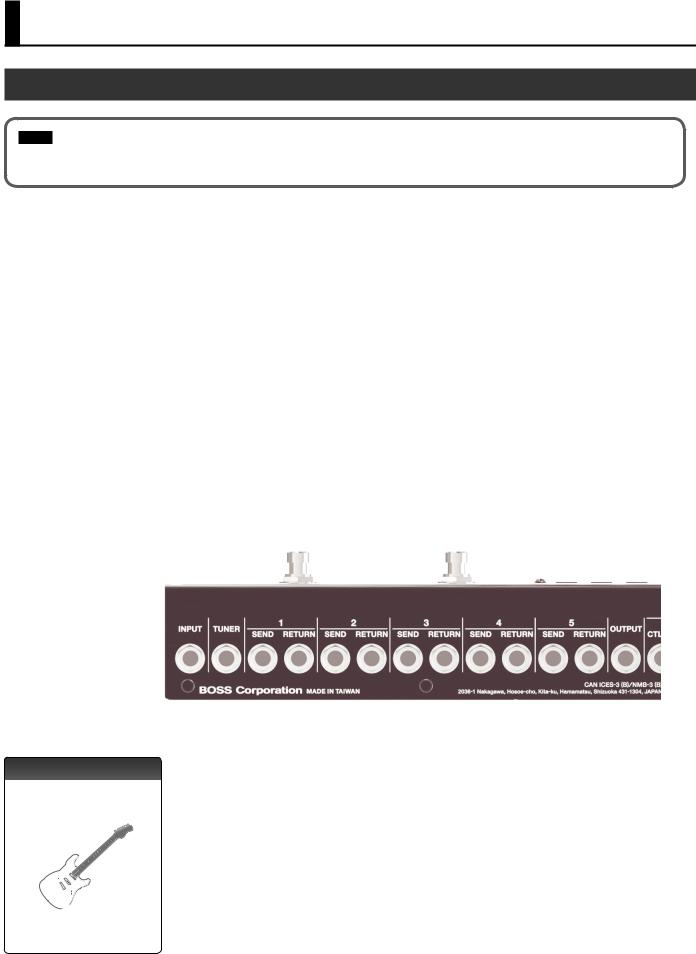
Panel Descriptions
Rear Panel (Connecting Your Equipment)
NOTE
To prevent malfunction and equipment failure, always turn down the volume, and turn off all the units before making any connections.
SEND 1–5, RETURN 1–5 jacks
These jacks provide effect loops.
Signals are sent from SEND 1–5 jacks to each effect unit, and the signals from each effect unit are received at the RETURN 1–5 jacks.
Connect the SEND 1–5 jacks to the INPUT jack of each effect unit, and connect the OUTPUT jack of each effect unit to the RETURN 1–5 jacks.
What is an effect loop?
This is a connection in which an effect device is connected via send and return jacks. The ES-5 provides five effect loops, 1–5.
RETURN |
SEND |
RETURN |
SEND |
INPUT jack
Connect your guitar or bass to this jack.
TUNER jack
This jack is for connecting an external tuner.
The signal that is input from the INPUT jack is output from this jack even if mute is on.
OUTPUT jack
This is the output jack.
Pressing the [MUTE] switch mutes the output from the OUTPUT jack.
2
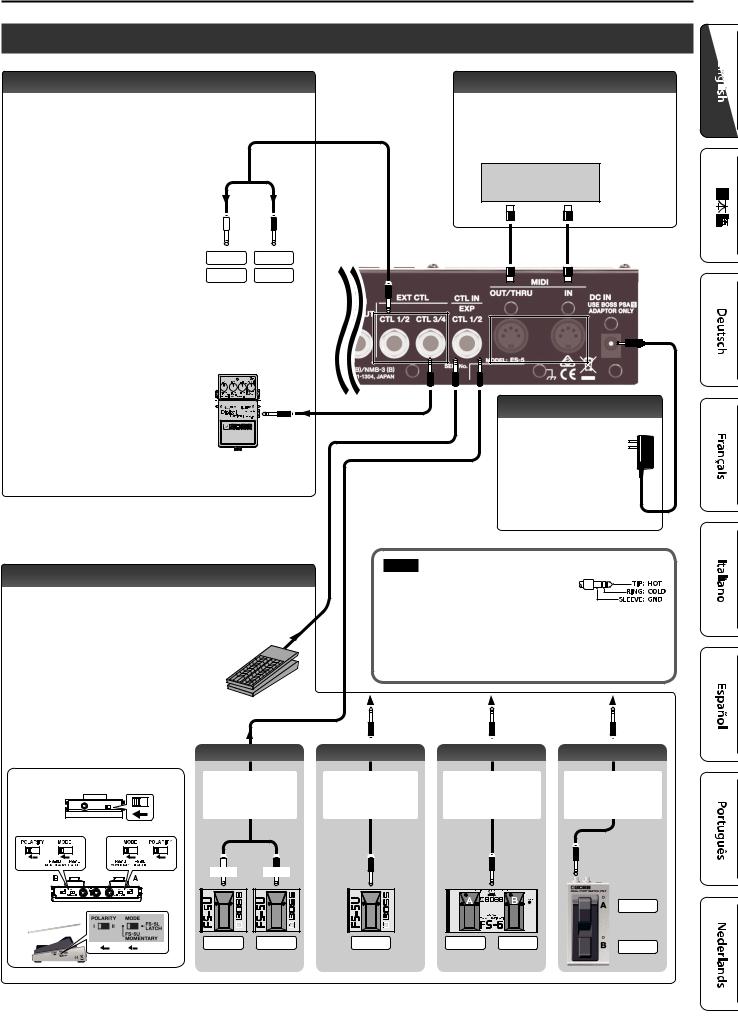
Panel Descriptions
EXT CTL jacks
CTL 1/2, 3/4 jacks
These are control jacks for latch or momentary operation.
You can use them to control various things such as switching amp channels or turning reverb on/off.
If you’re using an effect device that’s equipped with a footswitch jack, connect that jack here.
Each of these jacks can accommodate a stereo 1/4” plug (TRS) to make the appropriate connection to the device you’re controlling.
*If 1/4” plug cables are connected, only CTL 1 and CTL 3 are available.
TIP |
RING |
CTL 1 |
CTL 2 |
CTL 3 |
CTL 4 |
RETURN 












 SEND
SEND
CTL IN jack
These let you control effect units or amps that are connected to the EXT CTL jacks.
To use this as EXP jack
Connect an expression pedal (such as the Roland
EV-5).
To use this as CTL 1/2 jack
Connect a footswitch.
|
|
FS-5U x 2 |
Mode/Polarity switch |
Stereo 1/4” phone type |
|
FS-5U |
|
. |
|
/ |
|
|
1/4” phone type |
|
FS-6 |
|
|
|
TIP |
RING |
FS-7
CTL 1 |
CTL 2 |
MIDI connectors
Connect an external MIDI device here to transmit and receive MIDI messages.
The operation of the MIDI OUT/THRU connectors depends on the system settings (p. 12).
MIDI device
DC IN jack
Connect the included AC adaptor here.
The power turns on when you plug the connected AC adaptor into an AC outlet.
NOTE
55 This instrument is equipped with balanced (TRS) type jacks. Wiring diagrams for these jacks are shown below. Make connections
after first checking the wiring diagrams of other equipment you intend to connect.
55 Use only the specified expression pedal (FV-500H, FV-500L, Roland EV-5; sold separately). By connecting any other expression pedals, you risk causing malfunction and/or damage to the unit.
FS-5U |
|
x 1 |
|
|
|
|
|
FS-6 |
FS-7 |
||||
1/4” phone type |
Stereo 1/4” |
phone type |
Stereo 1/4” phone type |
|||
. |
. |
. |
||||
/ |
/ |
/ |
||||
1/4” phone type |
Stereo 1/4” phone type |
Stereo 1/4” phone type |
||||
CTL 2
CTL 1 |
CTL 2 |
CTL 1 |
CTL 1 |
|
|
|
3
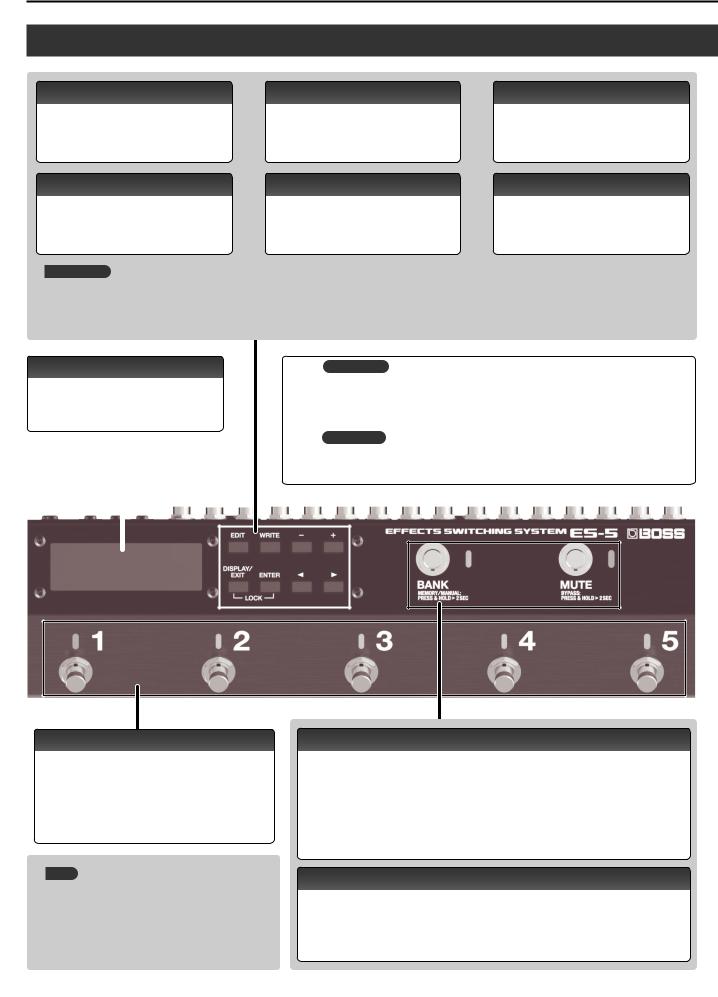
Panel Descriptions
Top Panel
[EDIT] button
Press this to make patch settings or system settings.
[WRITE] button
Press this to save patch settings.
[–] [+] buttons
Use these to edit the value of a setting.
*Hold down one button while pressing the other button to make the value change
[DISPLAY/EXIT] button |
[ENTER] button |
[K] [J] buttons |
Press this to switch the play screen, to cancel an operation, or to return to the previous screen.
Press this to confirm an operation.
Use these to move the cursor or to select a category or parameter.
When you press the [DISPLAY/EXIT] button and [ENTER] |
|
button simultaneously to activate |
|
|
|||||||
|
LOCKED! |
|
|||||||||
Lock function, all buttons will be disabled. |
|
|
|
|
|
|
|
|
|
||
This prevents settings from being changed when you |
|
inadvertently press a button. |
|
|
|||||||
The Lock function turns off when you press the two buttons simultaneously once again. |
|
|
|||||||||
|
|
||||||||||
|
|
|
|
|
|
|
|
|
|
|
|
Display |
What is memory mode? |
||||||||||
The ES-5 shows various information here. |
|
|
In this mode, you can select “patches,” where each patch is a combination of effect loops and various |
||||||||
|
|
settings. |
|||||||||
|
|
|
|
||||||||
|
|
|
|
You can select from 200 patches by using the buttons or switches to specify the group, bank, and |
|||||||
|
|
||||||||||
|
|
|
|
number. |
|||||||
|
|
|
|
|
|
|
|
|
|
||
|
|
What is manual mode? |
|||||||||
|
|
|
|
In this mode you can turn the effect loops (1–5) on/off individually. |
|||||||
|
|
|
|
|
|
|
|
|
|
|
|
|
|
|
|
|
|
|
|
|
|
|
|
|
|
|
|
|
|
|
|
|
|
|
|
Number switches [1]–[5]
Use these to select a patch number. The indicator of the currently selected number is lit blue.
In manual mode, these switches turn each effect loop (1–5) on/off individually. When an effect loop is on, its number indicator is lit red.
MEMO
You can also assign a different function to each switch (p. 10).
[BANK] switch
In memory mode, use this switch to change banks. Each time you press the switch, you’ll cycle through the banks in the order of 102030405010...
If you hold down this switch for two seconds or longer, you’ll switch between memory mode (indicator lit blue) and manual mode (indicator lit red).
If you like, you can make this indicator blink in time with the tempo (p. 12). * You can also change the way in which banks are switched (p. 12).
[MUTE] switch
Mutes the sound that is output from the ES-5. If mute is on, the indicator is lit blue.
Hold down the switch for two seconds or longer to enter the bypass state (indicator lit red); the input is output without change.
4
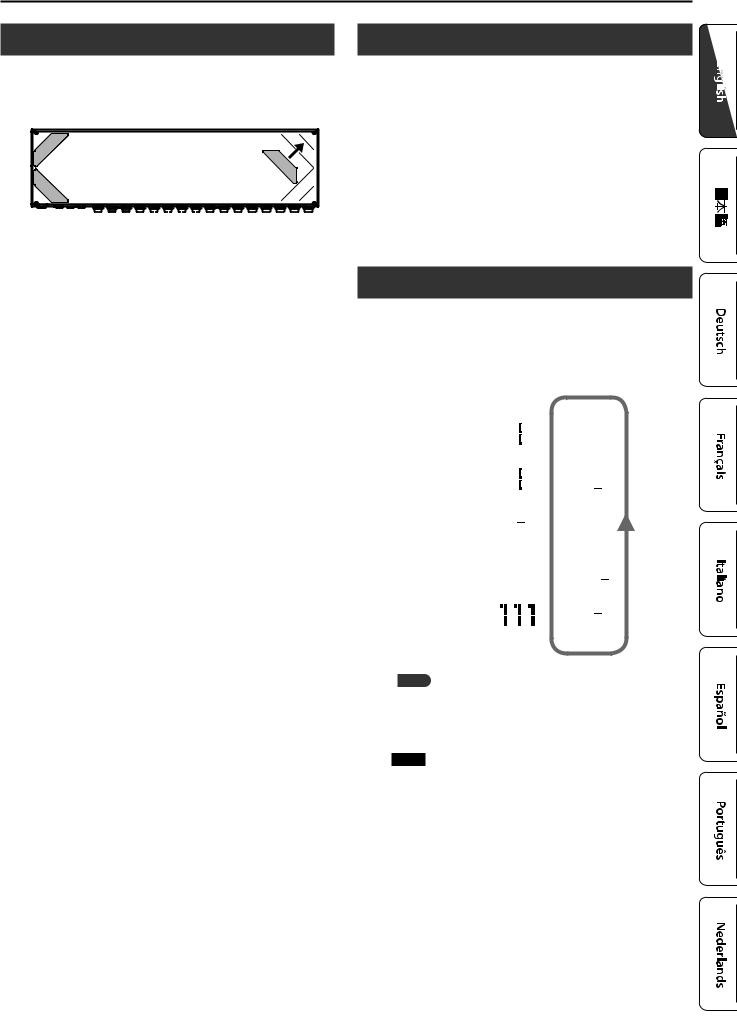
Panel Descriptions
Attaching the Rubber Feet
You can attach the rubber feet (included) if necessary.
Attach the rubber feet in alignment with the marks on the bottom of the unit.
*When turning the unit over, be careful so as to protect the buttons and switches from damage. Also, handle the unit carefully; do not drop it.
*If the rubber feet are not attached correctly, the unit may be deformed when you press the switches.
Turning the Power On and Off
Once everything is properly connected (p. 2), be sure to follow the procedure below to turn on their power. If you turn on equipment in the wrong order, you risk causing malfunction or equipment failure.
When powering up: Turn on the power to your guitar amp last.
When powering down: Turn off the power to your guitar amp first.
Switching the Play Screen
The screen that appears when you turn on the power is called the “play screen,” and the state in which the play screen is shown is called “play mode.”
There are five types of play screen as shown in the following illustration, and you can use the [DISPLAY/EXIT] button to switch between them.
Patch name screen |
111 |
BOSS ES-5 |
|
Master BPM& |
|
Ì=120 |
|
|
|
|
|
|
|
|
|
Loop On/Off screen |
111 |
BOSS ES-5 |
|
|
5 * 3 * 1 |
||
|
|
||
|
|
||
|
|
|
|
Loop structure screen |
O-5-4-3-2-1-I |
||
|
|
||
|
|
|
|
|
|
|
|
CTL out screen |
C1 |
|C2 |C3 |C4 |
|
ON|OFF| Ì |120 |
|||
|
|||
|
|
|
|
|
|
|
|
Patch number screen |
|
BOSS ES-5 |
|
|
Ì=120 |
||
|
|
||
|
|
|
|
MEMO
Even in play mode, you can use the [K] [J] buttons and [–] [+] buttons to edit the settings.
To save your edited settings, use the patch write (p. 6) operation.
NOTE
The explanations in this manual include illustrations that depict what should typically be shown by the display. Note, however, that your unit may incorporate a newer, enhanced version of the system (e.g., includes newer sounds), so what you actually see in the display may not always match what appears in the manual.
5

Saving/Recalling a Combination of Effect Units (Memory Mode)
“Memory mode” is the mode in which you can save combinations of effect loops (patches) in the ES-5, and recall those saved settings. In contrast to memory mode, “manual mode” is the mode in which you can use the switches to turn each effect loop on/off manually.
Patch Structure
A “patch” consists of a combination of effect loops (each effect loop’s on/off status and connection order) and parameter settings.
Patches are organized by group (1–8), bank (1–5), and number (1–5). You can store 200 patches.
 Patch 855
Patch 855
Patch |
113 |
|
Patch |
112 |
|
Patch |
111 |
(Group/Bank/Number) |
Group |
|
Group |
|||||||
|
Bank |
|
|
Bank |
|||||
|
|
Number |
|
|
|
Number |
|||
|
|
|
|
|
|
|
|
|
|
|
|
|
|
|
|
|
|
|
|
111 BOSS ES-5 |
|
|
|
|
|
BOSS ES-5 |
|||
Ì=120 |
|
Ì=120 |
|||||||
|
|
|
|
|
|
|
|
|
|
Switching Between Memory and Manual
Modes
1. Hold down the [BANK] switch for two seconds or longer.
Each time you press this switch, you alternate between memory mode and manual mode.
55 In memory mode, the BANK (MEMORY/MANUAL) indicator is lit blue.
55 In manual mode, the BANK (MEMORY/MANUAL) indicator is lit red.
In manual mode
Pressing the number switches [1]–[5] turns each effect loop on/off.
55 The number indicator is lit red if the corresponding effect loop is on, and unlit if that effect loop is off.
111 BOSS ES-5 |
|
|
1, 3, 5 |
On |
5 * 3 * |
1 |
|
2, 4 |
Off |
|
|
|
||
|
|
|
|
|
Saving a Patch (Patch Write)
NOTE
55 The patch you created is lost if you turn off the power or switch patches before performing the patch write operation.
55 When you perform the patch write operation, the patch that was in the save-destination is lost.
1. Press the [WRITE] button.
111
Patch name
2.Use the [K] [J] buttons and [–] [+] buttons to select the save-destination group/bank/patch number.
*You can also use the [BANK] switch and number switches [1]–[5] to select the bank number and patch number.
3.Press the [ENTER] button.
4.Use the [K] [J] buttons and [–] [+] buttons to assign a patch name.
*If you decide to cancel the patch write operation, press the [DISPLAY/EXIT] button several times.
5.Press the [WRITE] button or the [ENTER] button.
The display indicates “Executing...,” and then the previous display reappears when patch write is completed.
MEMO
55 You can write a patch from either memory mode or manual mode.
55 When you write a patch, the ES-5 switches to memory mode.
Recalling a Patch (Patch Change)
1.Use the [K] [J] buttons and [–] [+] buttons to select a group.
2.Use the [BANK] switch to select a bank.
3.Use the number switches [1]–[5] to select a patch.
MEMO
55 In the patch name screen and patch number screen of Play mode, you can use the [K] [J] buttons and [–] [+] buttons to select a patch.
55 You can choose whether pressing the [BANK] switch cycles through banks 1–5, or whether banks 1–5 are selected by pressing the [BANK] switch and then pressing one of the number switches [1]–[5].
For details on how to make this setting, refer to “Making Global Settings (System Setting)” (p. 12).
55 You can specify whether the next patch is selected as soon as you use the [BANK] switch to change banks, or whether the patch is not changed until you then press a number switch.
For details on how to make this setting, refer to “Making Global Settings (System Setting)” (p. 12).
6
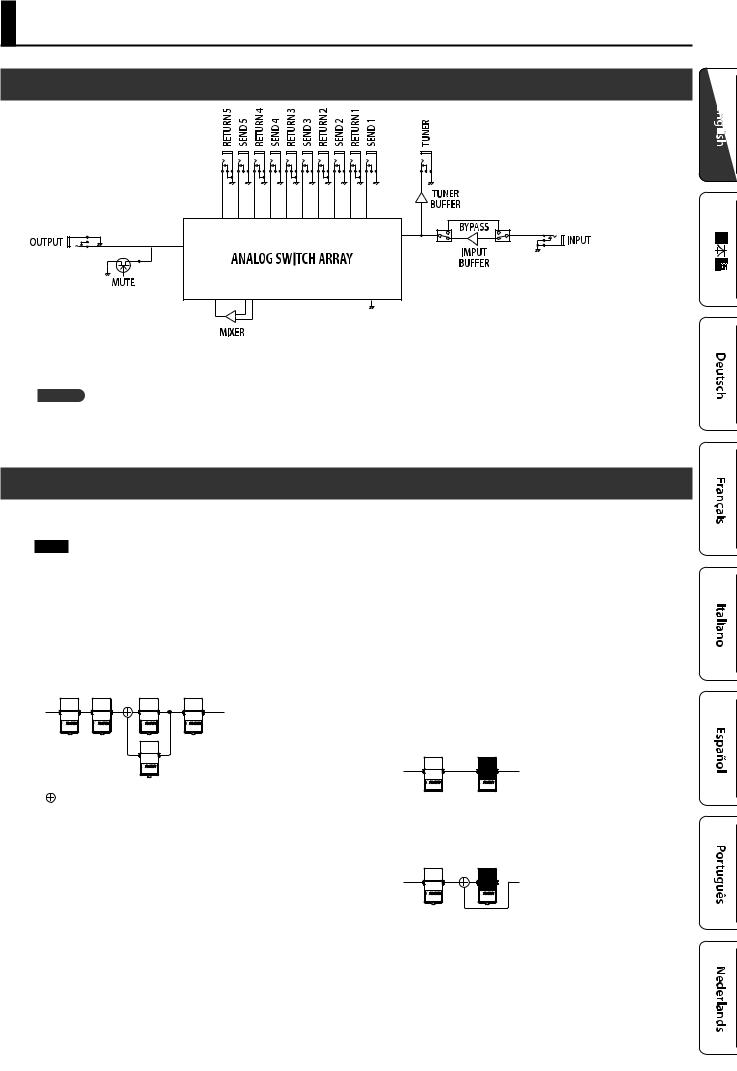
Creating a Patch
Block Diagram
The ES-5 uses an “analog switch array” that lets you freely change the connection order of your effect units.
It also contains an internal mixer, and lets you create a wide range of sounds by connecting effect units in parallel or using the “Carryover” function.
Carryover
This function cuts only the input while leaving the output connected when you change patches. For example, you can use this to allow just the delay sound to remain when switching patches.
Tips for Creating Patches (Sounds)
Using the internal mixer is important in order to take advantage of the ES-5’s unique features, such as the ability to connect loops in parallel and use the Carryover function. Understanding how to use the mixer will make it even more enjoyable to create patches (sounds).
NOTE
55 The same mixer is used for parallel connections and for Carryover. This means that depending on the settings, you might not be able to use a parallel connection, or that Carryover might not work.
55 If you connect a loop in parallel or if you use the Carryover function, the mixer is configured appropriately for the parallel connections or Carryover settings.
If you turn on the mixer without specifying parallel connections or Carryover, the mixer is configured immediately before the output.
Parallel connection |
Using the Carryover function |
|
This lets you preserve the sound (e.g., delay sound) when you switch |
|
patches. |
|
55 Before the patch change |
|
Delay |
: Mixer |
55 After the patch change |
|
|
|
The send to the delay loop is cut, and only the return is mixed |
|
with the direct sound. |
|
’Delay sound |
|
Delay |
|
’Direct sound |
|
* To use the Carryover function, enable Carryover for the patch that |
|
follows the patch change. |
|
* Carryover might not work if the Loop Structure (p. 9) settings |
|
differ before and after the patch change. |
7
